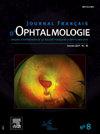Épidémiologie et caractéristiques des uvéites en Picardie sur 10 ans
IF 1.2
4区 医学
Q3 OPHTHALMOLOGY
引用次数: 0
Abstract
Objectif
Décrire les caractéristiques démographiques, cliniques, les étiologies retrouvées et la prise en charge des patients ayant consulté pour une uvéite dans un centre secondaire.
Matériel et méthodes
Il s’agit d’une étude rétrospective incluant les patients de plus de 18 ans ayant été pris en charge pour une uvéite entre janvier 2013 et janvier 2023 dans un hôpital universitaire de Picardie. Les données démographiques, caractéristiques cliniques, les étiologies et les traitements ont été recueillis.
Résultats
Au total, 1082 patients ont été inclus, répartis en 537 hommes (49,7 %) et 545 femmes (50,3 %). L’âge moyen à la première consultation était de 48,2 ans ± 18,6 ans. La localisation anatomique la plus fréquente était l’uvéite antérieure avec 784 cas (72,5 %), suivie de la panuvéite avec 133 cas (12,3 %). L’uvéite postérieure et l’uvéite intermédiaire étaient moins fréquentes avec respectivement 103 cas (9,5 %) et 62 cas (5,7 %). Une étiologie a été retrouvée dans 65,3 % des uvéites antérieures, 73,8 % des uvéites postérieures et 64,7 % des panuvéites, tandis que seules 38,7 % des uvéites intermédiaires ont abouti à une étiologie. Les causes d’uvéites les plus fréquentes étaient les uvéites liées aux virus du groupe herpès, les uvéites liées à HLA B-27, la sarcoïdose et la toxoplasmose. Parmi les patients présentant une uvéite non infectieuse, 111 (10,3 %) ont bénéficié de corticoïdes par voie systémique, 93 (8,5 %) ont été traités par des immunosuppresseurs, et 67 (6,2 %) ont reçu des biothérapies.
Conclusion
Ces résultats reflètent avec précision les caractéristiques sociodémographiques et cliniques des patients atteints d’uvéite dans le nord de la France. Les schémas de présentation des uvéites montrent des similitudes et des différences distinctes selon des facteurs géographiques et environnementaux.
Purpose
To describe the demographic and clinical characteristics, etiology and management of patients presenting with uveitis to a secondary center.
Materials and methods
This was a retrospective, single-center study including patients over 18 years of age who were diagnosed with uveitis and followed between January 2013 and January 2023.
Results
In all, 1082 patients, 537 men (49.7%) and 545 women (50.3%), were included. The mean age at the first visit was 48.2 ± 18.6 years. The most frequent anatomical location was anterior uveitis (784 cases, 72.5%), followed by panuveitis (133 cases, 12.3%). Posterior uveitis (103 cases, 9.5%) and intermediate uveitis (62 cases, 5.7%) were less common. An etiology was identified in 65.3% of anterior uveitis, 73.8% of posterior uveitis, and 64.7% of panuveitis. In contrast, only 38.7% of intermediate uveitis cases had an identified etiology. The most frequent causes of uveitis were herpes group virus-related uveitis, HLA B-27 related uveitis, sarcoidosis, and toxoplasmosis. Among patients with non-infectious uveitis, 111 (10.3%) were treated with systemic corticosteroids, 93 (8.5%) with antimetabolites as a steroid-sparing approach, and 67 (6.2%) received biologic therapy.
Conclusion
These results summarize the sociodemographic and clinical characteristics of patients with uveitis in northern France. There are distinct similarities and differences in the patterns of uveitis presentation, varying significantly according to geographical and environmental factors, which may help physicians in this region to manage uveitis.
皮卡第10年葡萄的流行病学与特征
描述人口统计、临床特征、病因和在二级中心咨询卵巢的患者的管理。这是一项回顾性研究,包括2013年1月至2023年1月期间在皮卡第大学医院接受卵巢护理的18岁以上患者。收集了人口统计数据、临床特征、病因和治疗。结果共纳入1082例患者,分为537名男性(49.7%)和545名女性(50.3%)。第一次会诊的平均年龄为48.2±18.6岁,最常见的解剖部位是前胎,784例(72.5%),其次是panuveite, 133例(12.3%)。后胎和中间胎的发生率较低,分别为103例(9.5%)和62例(5.7%)。65.3%的前胎、73.8%的后胎和64.7%的泛胎出现病因,而只有38.7%的中间胎出现病因。最常见的病因是与疱疹群病毒、HLA B-27相关的病因、结节病和弓形虫病。在非传染性葡萄球菌患者中,111例(10.3%)接受全身糖皮质激素治疗,93例(8.5%)接受免疫抑制剂治疗,67例(6.2%)接受生物治疗。结论这些结果准确地反映了法国北部卵巢患者的社会人口和临床特征。根据地理和环境因素的不同,幼苗的呈现模式显示出明显的异同。目的描述Uveitis患者在二级中心的人口统计学和临床特征、病因和管理。这是一项回顾性的单中心研究,包括2013年1月至2023年1月期间被诊断为尿路感染的18岁以上患者。结果总共包括1082例患者,537名男性(49.7%)和545名女性(50.3%)。第一次访问时的平均年龄为48.2±18.6岁。最常见的解剖部位是黄斑丘疹(784例,72.5%),其次是泛黄斑丘疹(133例,12.3%)。后遗症(103例,9.5%)和中生代(62例,5.7%)不太常见。65.3%的前uveitis、73.8%的后uveitis和64.7%的panuveitis被确定为病因。相比之下,只有38.7%的中介性静脉炎病例已确定病因。最常见的病因是疱疹群病毒相关的uveitis、HLA B-27相关uveitis、结节病和弓形虫病。在非传染性uveitis患者中,111人(10.3%)接受系统性皮质类固醇治疗,93人(8.5%)接受抗代谢物作为类固醇节省方法,67人(6.2%)接受生物治疗。结论:这些结果总结了法国北部uveitis患者的社会人口统计学和临床特征。Uveitis呈现的模式有明显的异同,根据地理和环境因素有很大的差异,这可能有助于该地区的医生管理Uveitis。
本文章由计算机程序翻译,如有差异,请以英文原文为准。
求助全文
约1分钟内获得全文
求助全文
来源期刊
CiteScore
1.10
自引率
8.30%
发文量
317
审稿时长
49 days
期刊介绍:
The Journal français d''ophtalmologie, official publication of the French Society of Ophthalmology, serves the French Speaking Community by publishing excellent research articles, communications of the French Society of Ophthalmology, in-depth reviews, position papers, letters received by the editor and a rich image bank in each issue. The scientific quality is guaranteed through unbiased peer-review, and the journal is member of the Committee of Publication Ethics (COPE). The editors strongly discourage editorial misconduct and in particular if duplicative text from published sources is identified without proper citation, the submission will not be considered for peer review and returned to the authors or immediately rejected.

 求助内容:
求助内容: 应助结果提醒方式:
应助结果提醒方式:


